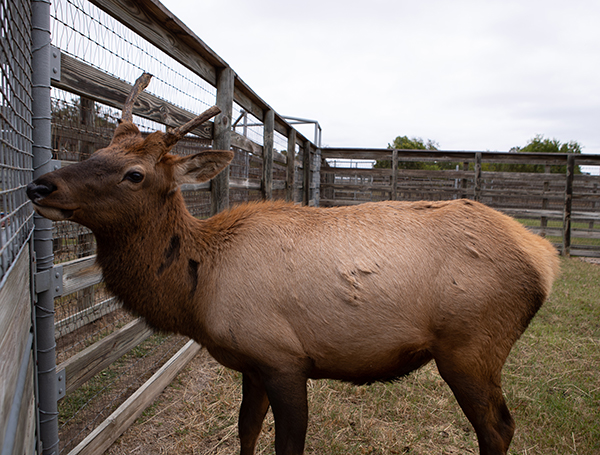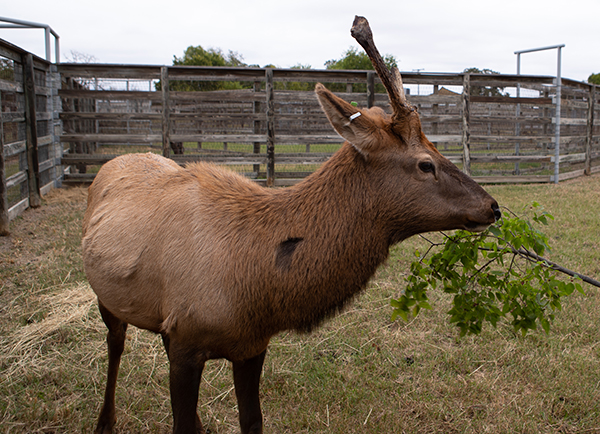Well-Known Elk Finds Forever Home at Texas A&M Wildlife Center
Story by Megan Myers, CVMBS Communications

Elliott the elk, a social media “celebrity” from Idaho, has joined the community of exotic animals at the Texas A&M College of Veterinary Medicine & Biomedical Sciences’ (CVM) Winnie Carter Wildlife Center.
Elliott’s journey to Texas A&M began when he was taken from the wild as a calf and raised by humans in Sweet, Idaho. Though he was released into the Bear Valley Campground area later by the Idaho Department of Fish and Game, he continually approached hunters and refused to join an elk herd.
Bobby and Robin Shindelar, hunters and outdoor enthusiasts, created the “Save Elliott” Facebook page to promote Elliott’s situation and help him find a safer permanent home. Their page grew to more than 1,000 members and has tracked Elliott’s journey since his relocation to Bear Valley.
When it became apparent that Elliott would never develop normal wild elk behavior, Idaho Fish and Game decided that Elliott needed a “forever home” where he could safely be cared for by humans for the rest of his life.
Elliott’s veterinarian in Idaho, Dr. Mark Drew, thought of Texas A&M and contacted Dr. Walter Cook, his former student who is now a CVM clinical associate professor. Cook reached out to his colleague Dr. Alice Blue-McLendon, director of the Winnie Carter Wildlife Center, and they agreed that Texas A&M would be the best place for the elk.
Blue-McLendon acquired special permissions from animal regulatory authorities to safely move Elliott across state lines, then two of Cook’s graduate students, Chase Nunez and Logan Thomas, began preparing to bring Elliott to his new home in College Station.
They set out on Oct. 17 to meet Elliott, who was brought down to Pueblo, Colorado, by a volunteer driver from Idaho.
“Apparently Elliott was really well behaved and went right from one trailer to the other,” Blue-McLendon said. “He was a very good boy. We had to make sure that both trailers had sliding doors so we didn’t have an elk running down the street.”
Luckily, Elliott’s transfer went smoothly and he was soon on his way to Texas. Both the graduate students, who spent 36 hours on the road, are looking forward to receiving Elliott’s antler sheds as thank you gifts from Blue-McLendon.

Now at his new home, Elliott is settling in nicely and enjoying the attention from those at the Wildlife Center.
“We’re happy to have Elliot and I think we’re a really good fit for him because we can provide a place for him long-term,” Blue-McLendon said. “He’ll get the best care here and he has access to the best veterinarians in the world. He’ll get lots of attention and have a happy life.”
Elliott, nicknamed “Elliott Waldo” after Walter “Waldo” Cook, will be cared for by Blue-McLendon, the Wildlife Center staff, and the undergraduate and veterinary students who volunteer and take classes at the center.
“It’s exciting and fun to have a new animal,” Blue-McLendon said. “More work to do and more mouths to feed, but the students always like something new to do; they thrive on diversity.”
“He’ll end up being one of the largest animals that has ever been at the Wildlife Center,” she said. “He’ll probably get to at least 800 pounds. He’s already the biggest thing that lives here now at 430 pounds.”
Currently, Elliott is being cared for under “protected contact,” which means the students and staff cannot enter his pen while he is inside. As a young male, Elliott is entering his first season of rut and has high levels of testosterone.
“It’s a super educational experience for veterinary students and undergrads,” Blue-McLendon said. “A lot of the students want to work with non-domestics when they become veterinarians or want to be zookeepers. It’s important to learn to work around animals that you can’t go in with and pet.”
The students may not be able to enter Elliott’s pen, but that doesn’t mean they love him any less than the other animals at the Wildlife Center.
“He already has quite the following (among the students),” Blue-McLendon said. “They all love him. Everyone can pet him through the fence.”
Thanks to his social media fame, Elliott has already had visitors from outside the CVM as well, including a couple from Idaho who stopped by to see him when they came down to watch a Texas A&M football game.
Once this rutting season is over, Blue-McLendon hopes that Elliott’s behavior will improve and he will become gentler around people.
“We’re hoping that he’ll be more tractable and that he’ll be friendly, but we’ll always have to be cautious with him,” she said. “But it’s normal for most hand-raised males to go back to being nicer individuals toward humans (after rutting season ends).”
No matter how his attitude turns out, Elliott will be cared for and loved at the Winnie Carter Wildlife Center for the rest of his life.
While everything turned out well for Elliott, that is not always the case for wild animals taken into captivity by humans. Blue-McLendon reminds animal lovers that if they become concerned about a wild animal, it is always better to contact a wildlife official rather than interact with the animal themselves.
Thanks to the dedication shown by Idaho Fish and Game members, the Texas A&M Winnie Carter Wildlife Center, and his many faithful fans online, Elliott has found his happy ending at Texas A&M.
###
For more information about the Texas A&M College of Veterinary Medicine & Biomedical Sciences, please visit our website at vetmed.tamu.edu or join us on Facebook, Instagram, and Twitter.
Contact Information: Jennifer Gauntt, Interim Director of CVM Communications, Texas A&M College of Veterinary Medicine & Biomedical Science; jgauntt@cvm.tamu.edu; 979-862-4216


